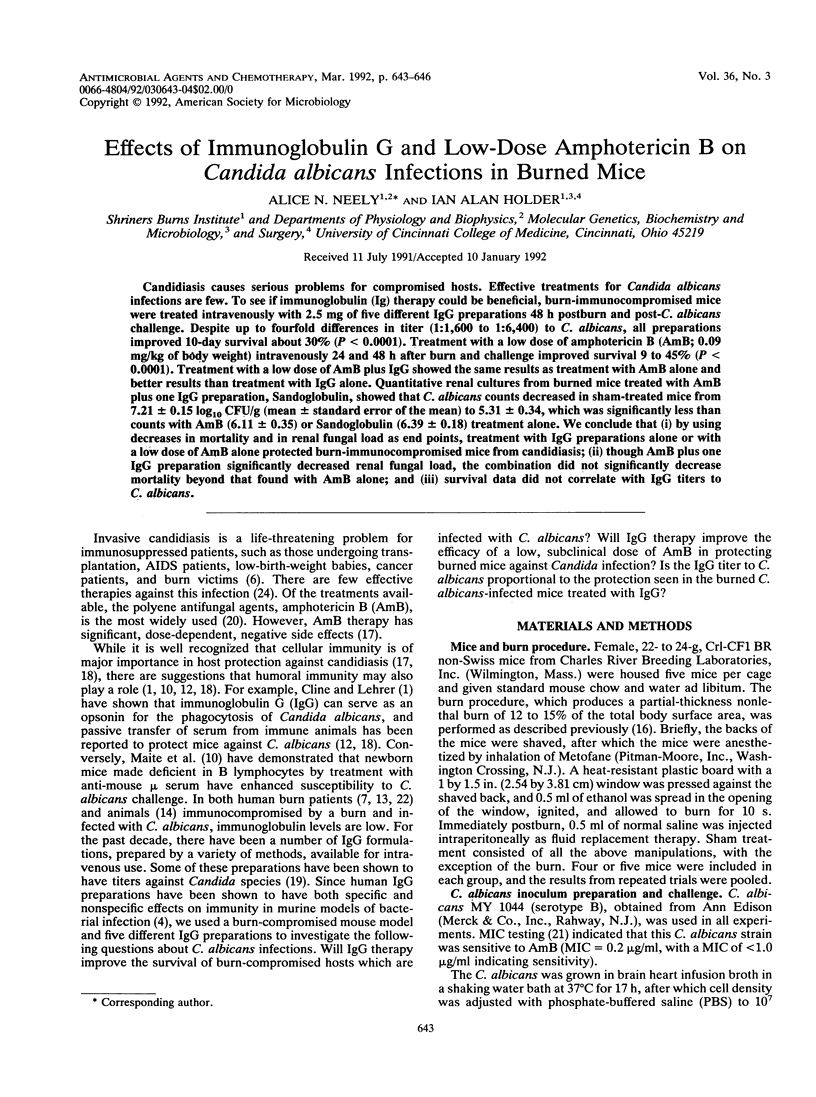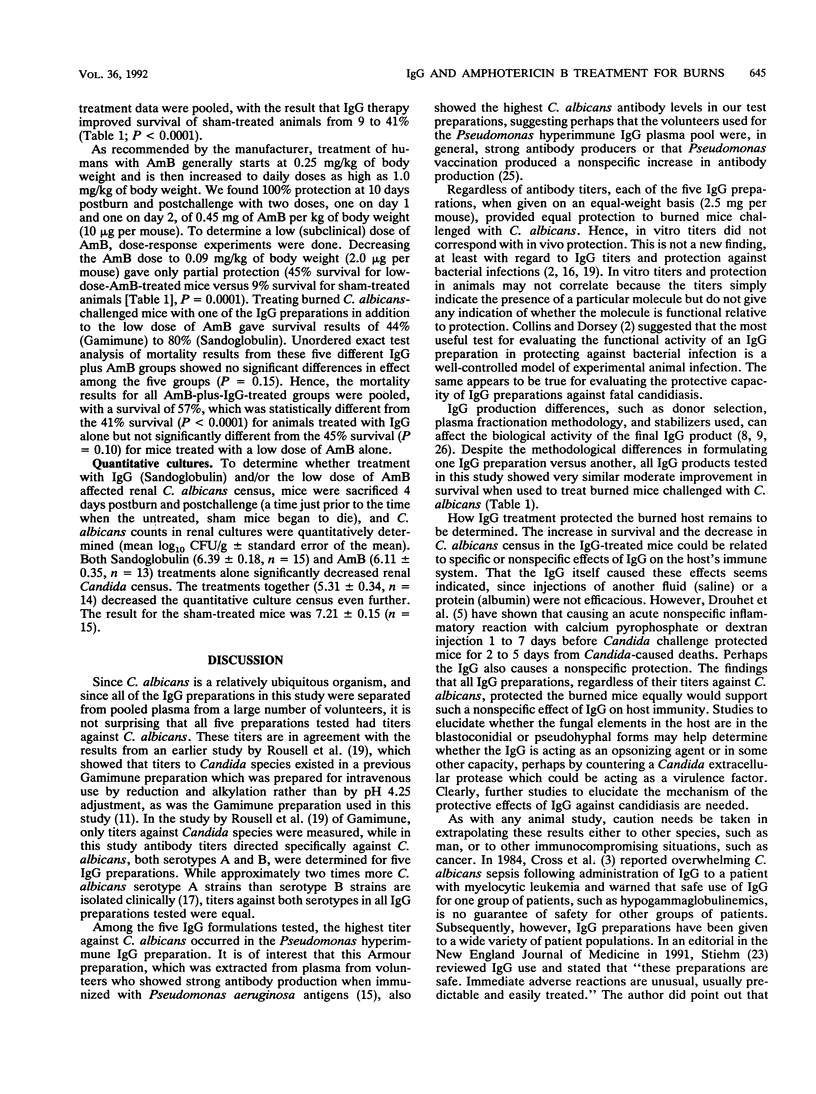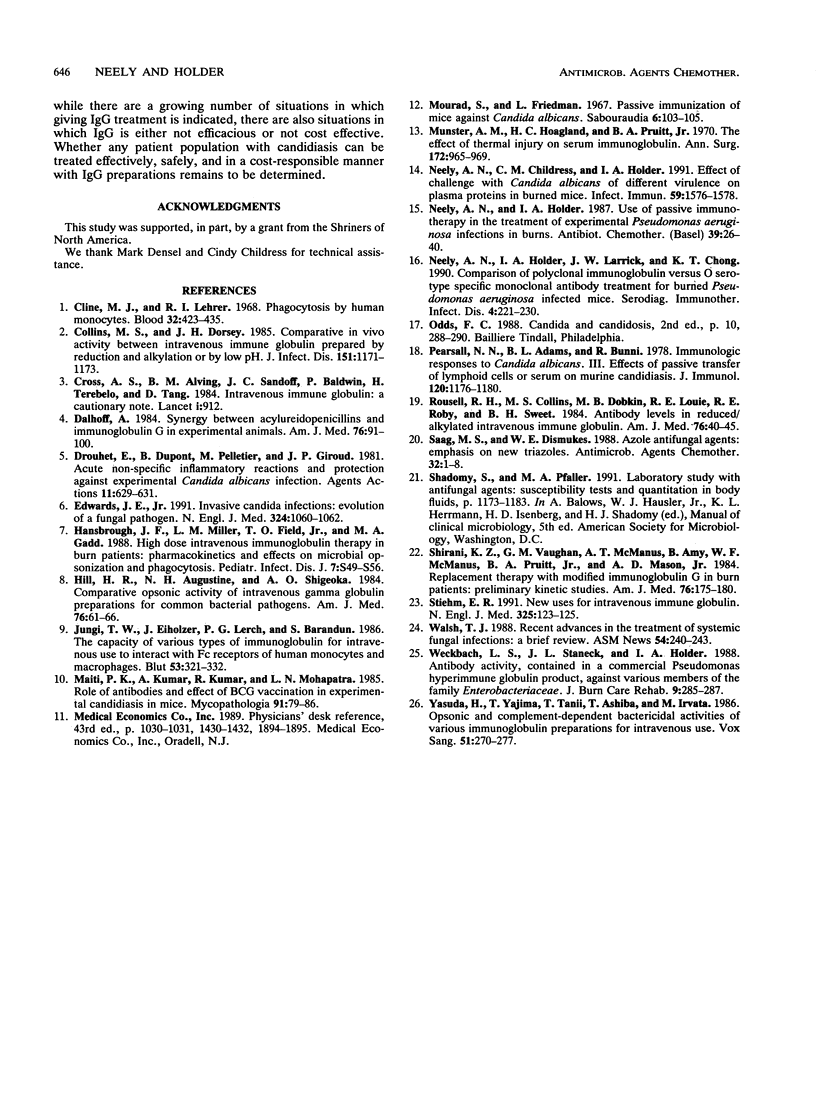Abstract
Candidiasis causes serious problems for compromised hosts. Effective treatments for Candida albicans infections are few. To see if immunoglobulin (Ig) therapy could be beneficial, burn-immunocompromised mice were treated intravenously with 2.5 mg of five different IgG preparations 48 h postburn and post-C. albicans challenge. Despite up to fourfold differences in titer (1:1,600 to 1:6,400) to C. albicans, all preparations improved 10-day survival about 30% (P less than 0.0001). Treatment with a low dose of amphotericin B (AmB; 0.09 mg/kg of body weight) intravenously 24 and 48 h after burn and challenge improved survival 9 to 45% (P less than 0.0001). Treatment with a low dose of AmB plus IgG showed the same results as treatment with AmB alone and better results than treatment with IgG alone. Quantitative renal cultures from burned mice treated with AmB plus one IgG preparation, Sandoglobulin, showed that C. albicans counts decreased in sham-treated mice from 7.21 +/- 0.15 log10 CFU/g (mean +/- standard error of the mean) to 5.31 +/- 0.34, which was significantly less than counts with AmB (6.11 +/- 0.35) or Sandoglobulin (6.39 +/- 0.18) treatment alone. We conclude that (i) by using decreases in mortality and in renal fungal load as end points, treatment with IgG preparations alone or with a low dose of AmB alone protected burn-immunocompromised mice from candidiasis; (ii) though AmB plus one IgG preparation significantly decreased renal fungal load, the combination did not significantly decrease mortality beyond that found with AmB alone; and (iii) survival data did not correlate with IgG titers to C. albicans.
Full text
PDF



Selected References
These references are in PubMed. This may not be the complete list of references from this article.
- Cline M. J., Lehrer R. I. Phagocytosis by human monocytes. Blood. 1968 Sep;32(3):423–435. [PubMed] [Google Scholar]
- Collins M. S., Dorsey J. H. Comparative in vivo activity between intravenous immune globulin prepared by reduction and alkylation or by low pH. J Infect Dis. 1985 Jun;151(6):1171–1173. doi: 10.1093/infdis/151.6.1171. [DOI] [PubMed] [Google Scholar]
- Cross A. S., Alving B. M., Sadoff J. C., Baldwin P., Terebelo H., Tang D. Intravenous immune globulin: a cautionary note. Lancet. 1984 Apr 21;1(8382):912–912. doi: 10.1016/s0140-6736(84)91376-x. [DOI] [PubMed] [Google Scholar]
- Dalhoff A. Synergy between acylureidopenicillins and immunoglobulin G in experimental animals. Am J Med. 1984 Mar 30;76(3A):91–100. doi: 10.1016/0002-9343(84)90326-7. [DOI] [PubMed] [Google Scholar]
- Drouhet E., Dupont B., Pelletier M., Giroud J. P. Acute non-specific inflammatory reactions and protection against experimental Candida albicans infection. Agents Actions. 1981 Dec;11(6-7):629–631. doi: 10.1007/BF01978770. [DOI] [PubMed] [Google Scholar]
- Edwards J. E., Jr Invasive candida infections--evolution of a fungal pathogen. N Engl J Med. 1991 Apr 11;324(15):1060–1062. doi: 10.1056/NEJM199104113241511. [DOI] [PubMed] [Google Scholar]
- Hansbrough J. F., Miller L. M., Field T. O., Jr, Gadd M. A. High dose intravenous immunoglobulin therapy in burn patients: pharmacokinetics and effects on microbial opsonization and phagocytosis. Pediatr Infect Dis J. 1988 May;7(5 Suppl):S49–S56. [PubMed] [Google Scholar]
- Hill H. R., Augustine N. H., Shigeoka A. O. Comparative opsonic activity of intravenous gamma globulin preparations for common bacterial pathogens. Am J Med. 1984 Mar 30;76(3A):61–66. doi: 10.1016/0002-9343(84)90321-8. [DOI] [PubMed] [Google Scholar]
- Jungi T. W., Eiholzer J., Lerch P. G., Barandun S. The capacity of various types of immunoglobulin for intravenous use to interact with Fc receptors of human monocytes and macrophages. Blut. 1986 Oct;53(4):321–332. doi: 10.1007/BF00320892. [DOI] [PubMed] [Google Scholar]
- Maiti P. K., Kumar A., Kumar R., Mohapatra L. N. Role of antibodies and effect of BCG vaccination in experimental candidiasis in mice. Mycopathologia. 1985 Aug;91(2):79–85. doi: 10.1007/BF00436540. [DOI] [PubMed] [Google Scholar]
- Mourad S., Friedman L. Passive immunization of mice against Candida albicans. Sabouraudia. 1968 Feb;6(2):103–105. [PubMed] [Google Scholar]
- Munster A. M., Hoagland H. C., Pruitt B. A., Jr The effect of thermal injury on serum immunoglobulins. Ann Surg. 1970 Dec;172(6):965–969. doi: 10.1097/00000658-197012000-00006. [DOI] [PMC free article] [PubMed] [Google Scholar]
- Neely A. N., Childress C. M., Holder I. A. Effect of challenge with Candida albicans strains with different levels of virulence on plasma proteins in burned mice. Infect Immun. 1991 Apr;59(4):1576–1578. doi: 10.1128/iai.59.4.1576-1578.1991. [DOI] [PMC free article] [PubMed] [Google Scholar]
- Neely A. N., Holder I. A. Use of passive immunotherapy in the treatment of experimental Pseudomonas aeruginosa infections in burns. Antibiot Chemother (1971) 1987;39:26–40. doi: 10.1159/000414331. [DOI] [PubMed] [Google Scholar]
- Pearsall N. N., Adams B. L., Bunni R. Immunologic responses to Candida albicans. III. Effects of passive transfer of lymphoid cells or serum on murine candidiasis. J Immunol. 1978 Apr;120(4):1176–1180. [PubMed] [Google Scholar]
- Saag M. S., Dismukes W. E. Azole antifungal agents: emphasis on new triazoles. Antimicrob Agents Chemother. 1988 Jan;32(1):1–8. doi: 10.1128/aac.32.1.1. [DOI] [PMC free article] [PubMed] [Google Scholar]
- Shirani K. Z., Vaughan G. M., McManus A. T., Amy B. W., McManus W. F., Pruitt B. A., Jr, Mason A. D., Jr Replacement therapy with modified immunoglobulin G in burn patients: preliminary kinetic studies. Am J Med. 1984 Mar 30;76(3A):175–180. doi: 10.1016/0002-9343(84)90338-3. [DOI] [PubMed] [Google Scholar]
- Stiehm E. R. New uses for intravenous immune globulin. N Engl J Med. 1991 Jul 11;325(2):123–125. doi: 10.1056/NEJM199107113250209. [DOI] [PubMed] [Google Scholar]
- Weckbach L. S., Staneck J. L., Holder I. A. Antibody activity, contained in a commercial pseudomonas hyperimmune globulin product, against various members of the family Enterobacteriaceae. J Burn Care Rehabil. 1988 May-Jun;9(3):285–287. doi: 10.1097/00004630-198805000-00010. [DOI] [PubMed] [Google Scholar]
- Yasuda H., Yajima T., Tanii T., Ashiba T., Iwata M. Opsonic and complement-dependent bactericidal activities of various immunoglobulin preparations for intravenous use. Vox Sang. 1986;51(4):270–277. doi: 10.1111/j.1423-0410.1986.tb01968.x. [DOI] [PubMed] [Google Scholar]


